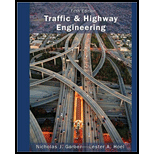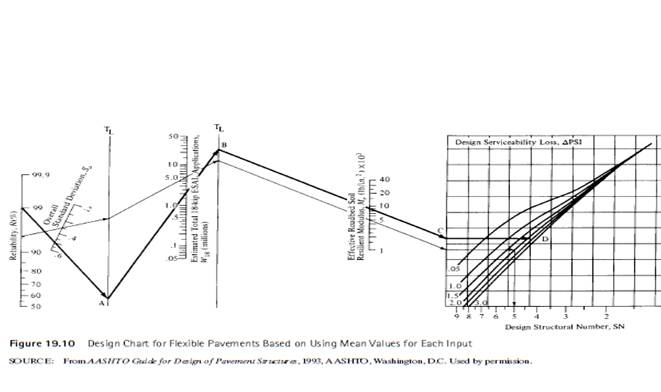
Concept explainers
Repeat Problem 19-7 using two different depths of untreated aggregate bases of 6 in. and 12 in. Highway contractors in your area can furnish rates for providing and properly laying an asphalt concrete surface and untreated granular base. Assume a structural coefficient of 0.12 for the base course. If these rates are available, determine the cost for constructing the different pavement designs if the highway section is 5 miles long and the lane width is 12 ft. Which design will you select for construction?
The cost for constructing the different pavement designs.
Answer to Problem 13P
Explanation of Solution
Given information:
Following is the given information:
Equivalent single axle load, ESAL =
CBR =
Subgrade resilient modulus =
Sub-base layer coefficient =
Granular base layer coefficient =
Elastic modulus of asphalt concrete =
mi = 1, Percentage of traffic on design lane =
SN = 4, reliability level =
and design serviceability loss =
Calculation:
We have the following formula for the calculation of truck factor:
Where, ESAL i= equivalent accumulated 18,000-lb (80-kN) single-axle load for the axle category i
fd= design lane factor,
G rn= growth factor for a given growth rate r and design period n
AADT i= first-year annual average daily traffic for axle category i
N i= number of axles on each vehicle in category i
F Ei= load equivalency factor for axle category i
Calculate ESAL for passenger car
We have the following formula for the calculation of design serviceability :
Substitute the values in the required equation.
Initial serviceability index,
Terminal serviceability index,
Let's determine the resilient modulus of subgrade:
The resilient modulus of subgrade is 1500 times CBR
The value of resilient modulus is given as follows:
Now for the structural number, SN refer to figure 19.10
The reliability level is 90%. Starting from the point 90% in figure, extend this point to standard deviation 0.45. From standard deviation point, extend this line to line A as given in the figure.
From line A extend this line to
From ESAL extend this line to line B in the figure.
From line B extend this line to
From M rextend this line till it touches the graph. From that point, draw a horizontal line to touch the design serviceability loss, which is 2.
Extend a line vertically and take the structural number SN3reading, which is 2.5 and SN2is 2.3
Then from figure 19.6, for layer coefficient and the resilient modulus for base layer is
From figure 19.10, resilient modulus is
Refer figure 19.7 to determine layer coefficient

Now, considering the thickness aggregate base as 6 inches.
Calculate the minimum thickness.
The layer coefficient,
Substitute the values
Checking the values, we have
As the values match, thus the thickness of subgrade calculated is correct.
Calculate the required minimum thickness of base course D2is 6 inches.
Check whether the calculated thickness agrees with the calculated structural number using equation
Substituting the values, we have
Which is compatible with the structural number calculated already.
And implies that the thickness of the surface calculated is correct.
Now, the required minimum thickness of the sub-base course
By substituting the values, we have
Now, check if the calculated thickness agrees with the calculated structural number of using the following equation:
Substituting the values
Which is compatible with the structural number calculated already.
And implies that the thickness of the surface calculated is correct.
The thickness of surface 4.25 inches.
Now, considering the thickness aggregate base as 12 inches.
Calculate the minimum thickness.
Substitute the values, we have
Thus, the thickness of sub grade is 1.7 in.
Now, the thickness of the base course is given as follows:
Substitute the values.
Which is greater than 2.7, i.e., structural number.
Now, the required minimum thickness of the sub-base course
By substituting the values,
Now, check if the calculated thickness agrees with the calculated structural number of using the following equation
Substituting the values,
Which is compatible with the structural number calculated already.
And implies that the thickness of the surface calculated is correct.
Calculate construction cost for the highway considering thickness of base layer as 6 inches and 12 inches.
The cost is calculated by multiplying the measurement of road with the cost per rate.
Assume cost of surface layer as
For cost of base layer
For cost of sub-base layer
The construction cost of the highway is as follows:
Cost = L X B X t X C
For surface layer :
Substitute the values
5 miles is equal to 26400
For base layer :
Substitute the values
For sub-base layer :
Substitute the values
Now, calculate the total cost as follows:
The construction cost of the highway is as follows:
Cost = L X B X t X C
For surface layer :
Substitute the values
5 miles is equal to 26400
For base layer :
Substitute the values
For sub-base layer :
Substitute the values
Now, calculate the total cost as follows:
Conclusion:
Therefore, out of two cases the construction cost is
Want to see more full solutions like this?
Chapter 19 Solutions
Traffic and Highway Engineering - With Mindtap
- REINFORCED CONCRETE DESIGNFLEXURAL ANALYSIS OF BEAMS (CRACKED SECTION)Solution must be completeUse ballpen/inkpenAnswer in two decimal placesBox your final answerarrow_forwardWhat is the volume of the earth's mantle in cubic kilometers? (tute problem 4d) Note: enter the number without units. For large (or small) numbers, use E notation, e.g. three million is equivalent to 3*10^6 which is 3E6 in E notation.arrow_forwardH.W: From an in-out survey conducted for a parking area consisting of 40 bays, the initial count was found to be 20 vehicles. Table gives the result of the survey. The number of vehicles coming in and out of the parking lot for a time interval of 5 minutes is as shown in the table below. Find the accumulation, total parking load, average occupancy and efficiency of the parking lot. Table: In-out survey data Time (minutes) In Out 5 3 2 10 6 2 15 3 1 20 6 7 25 6 4 30 8 6arrow_forward
- can you show me step for step? Autocad has me irritated.arrow_forwardmummins) Is there any risk from a contaminant if 150 out of 3800 people exposed to the groundwater contaminant develop cancer and 125 out of 5000 people not exposed to the contamination also develop cancer? Why or why not? Use at least two methods to support your answer.arrow_forwardA spare buoy is a buoyant rod weighted to float and protrude vertically, as shown in thefigure below. Suppose that the buoy is made of maple wood ( specific gravity s = 0.6), has arectangular cross section ( 2.54cm by 2.54cm ), a length of 3.7 m , and is floating in seawater( specific gravity s =1.025 ). What weight of steel should be added to the bottom end of thebuoy so that h=0.45 cm? ( The specific gravity of steel s = 7.85 )arrow_forward
- 8-42. Determine the displacement at point D. Use the principle of virtual work. El is constant. 60 kN 2m- 2 m B 30 kN/m 3 marrow_forwardTwo monitoring wells are spaced 500 m apart along the direction of groundwater flow in a confined aquifer 30.0 m thick. The difference in water level in the wells is 2.5 m. The hydraulic conductivity is 40 m/d. a) Sketch the aquifer and wells and label distances and direction of groundwater flow. b) If the real velocity of the groundwater is 0.6 m/d, what is the porosity? c) If it takes 10 years for a petroleum hydrocarbon plume to appear in the second well, what was the retardation factor?arrow_forward9. 0000) Water in a lake contains 10.5 ppb of vinyl chloride, which has a potency factor of 2.3 (mg/kg-d) 1 a. What is the incremental cancer risk for children (average weight of 15 kg) who may ingest 0.05 L of water per day while playing in the water every summer (for approximately 60 days) for 10 years? b. Is this risk acceptable? Why or why not?arrow_forward
- 8-37. Determine the displacement of point C. Use the method of virtual work. El is constant. -12 ft- 3 k/ft -12 ft- Barrow_forward6. If the initial DO concentration of a diluted (1/50) wastewater sample is 9.0 mg/L and the UO concentration decreases to 2.4 mg/L after 5 days of incubation, a. calculate the 5-day BOD concentration in mg/L: b. If the wastewater degrades at a rate of 0.22/day, what is the ultimate BOD concentration? c. Based on the k value in part (b), what would the BOD concentration be after 10 days? d. What other factor may influence the BOD that is not accounted for in part (c)?arrow_forward2nYour consulting firm is doing an expansion project for a drinking water treatment plant in a growing urban area that has a current population of 55,000 people and treats 20 MGD. If there is 2.8% population growth, continuously compounded, and you want the expansion to be able to serve the urban area for the 35 year design life of the upgraded facility, what should the new design capacity (in MGD) of the treatment plant be?arrow_forward
 Traffic and Highway EngineeringCivil EngineeringISBN:9781305156241Author:Garber, Nicholas J.Publisher:Cengage Learning
Traffic and Highway EngineeringCivil EngineeringISBN:9781305156241Author:Garber, Nicholas J.Publisher:Cengage Learning Construction Materials, Methods and Techniques (M...Civil EngineeringISBN:9781305086272Author:William P. Spence, Eva KultermannPublisher:Cengage Learning
Construction Materials, Methods and Techniques (M...Civil EngineeringISBN:9781305086272Author:William P. Spence, Eva KultermannPublisher:Cengage Learning Fundamentals Of Construction EstimatingCivil EngineeringISBN:9781337399395Author:Pratt, David J.Publisher:Cengage,
Fundamentals Of Construction EstimatingCivil EngineeringISBN:9781337399395Author:Pratt, David J.Publisher:Cengage, Principles of Geotechnical Engineering (MindTap C...Civil EngineeringISBN:9781305970939Author:Braja M. Das, Khaled SobhanPublisher:Cengage Learning
Principles of Geotechnical Engineering (MindTap C...Civil EngineeringISBN:9781305970939Author:Braja M. Das, Khaled SobhanPublisher:Cengage Learning Solid Waste EngineeringCivil EngineeringISBN:9781305635203Author:Worrell, William A.Publisher:Cengage Learning,
Solid Waste EngineeringCivil EngineeringISBN:9781305635203Author:Worrell, William A.Publisher:Cengage Learning,




